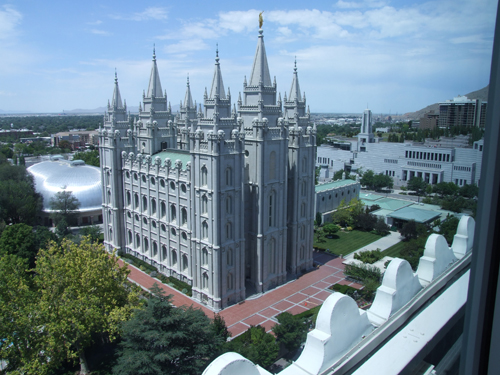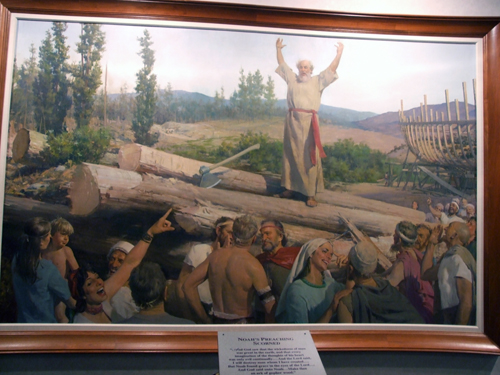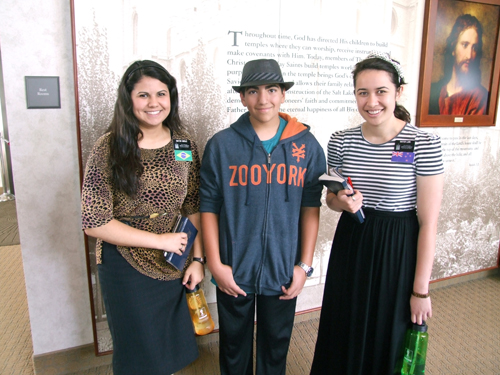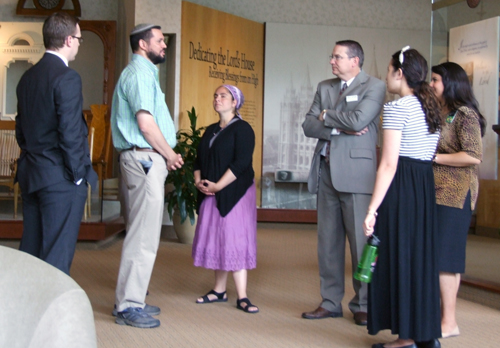
-Eleventh in a Series-
By Donald H. Harrison

SALT LAKE CITY, Utah — As one drives north on the Interstate 15 towards Salt Lake City, a Jew might get the impression of being surrounded by a familiar heritage, and also by one that is altogether new. In Utah, one passes through the northwest corner of Zion National Park, and later through the town of Enoch, named for the biblical figure who was the great grandfather of Noah. Further north there is Benjamin, named for the youngest son of Jacob. And then there is Lehi, which a student of Hebrew Scriptures might think refers to a place mentioned in the biblical story of Sampson.
But in fact, Lehi refers to one of the prophets who is in the Book of Mormon. According to this scripture of the Church of Jesus Christ of Latter-day Saints, Lehi and his son, Nephi, (for whom another Utah town is named) and others left Israel by ship in the 6th century BCE and sailed to North America, where God settled them in the new Promised Land.
Visiting Temple Square in Salt Lake City, one gets the same mixed feeling of familiarity and novelty. In one visitors center (there are two), one finds wonderful paintings showing scenes from Hebrew Scriptures (Old Testament), Christian Scriptures (New Testament) and the Book of Mormon. Tanach-conscious Jews will instantly recognize a sculpture of Adam and Eve (clothed) in the Garden of Eden; Noah being derided by the people of his time; Abraham learning that he will become a father; Jacob blessing his sons; Aaron being installed as a priest; Samuel receiving the gift of prophecy; and Daniel interpreting dreams for King Nebuchadnezzar. Then the paintings segui into Christian and Mormon scriptures, the latter unfamiliar to many Jews.

Shor and I did not encounter anyone attempting to proselytize us Jews as we visited various venues in Temple Square, including the famous Tabernacle where the Mormon Tabernacle Choir performs, and a new 21,000-seat conference center which Mormons believe may be the largest religious center in the world. Besides for religious meetings, it also is utilized for concerts and other mass events.
Who we did meet were “sisters” –single, college-aged women from various parts of the world –who, in pairs, narrated tours at the various places of interest around Temple Square. There are numerous religious and historical sites to be seen, including the sprawling home of Brigham Young, the Mormon church’s second president (after Joseph Smith) and the Utah Territory’s first governor. The sisters wore name plates, identifying their countries of origin, and worked in tandem as hostesses at the sites. Perhaps because the sisters are temporary volunteers, subject to making mistakes, the Mormons did not permit visitors to tape record their talks. Nor were any senior officials from the office of inter-religious affairs willing to go on the record for this article as they accompanied Shor, me, and Rabbi Uri and Dahlia Topolosky of Beth Joshua Congregation of Rockville, Maryland, on a tour. However, Eric Hawkins, the senior manager for public relations of the Church of Latter-day Saints, was kind enough to answer questions by e-mail following our visit.


Through the good offices of a mutual Jewish friend, Shor and I were hosted by a very kind and friendly Mormon couple, with whom we discussed some important issues–albeit on the basis that I neither quote them by name nor suggest that they, in any way, spoke officially for the church. These requests I am happy to comply with.
The first topic of discussion came up at lunch, as we sat high above Temple Square enjoying a view of the Mormon Temple building, or what might be called the mother church. Our host mentioned that the church had favored California’s Proposition 8, which had banned same-sex marriages, and Shor immediately, but respectfully, staked out the opposite position. He told of being a member of Temple Emanu-El in San Diego where one of his bar mitzvah classmates “has two fathers”–both of whom are active in the congregation and are well-respected. “I believe that people should be allowed to love whom they want!” Shor declared.
I believe our host was impressed both with Shor’s forthrightness and the respectful, non-belligerent, way he put forward his point of view. The man told of his own belief that permitting same-sex marriages violates God’s intentions for humanity (“‘be fruitful and multiply”) and also leads to a slippery slope which could result in states legalizing marriage between siblings, parents and children, and other relationships forbidden in the Bible. Neither our host, nor Shor, convinced the other, but they did, I believe, have a better understanding of each other’s point of view. I was proud that Shor, at 13, stood up for his beliefs, all the while stating them in a way intended to explain, rather than to antagonize.
Hawkins, in our email correspondence, said: “The Church of Jesus Christ of Latter-day Saints remains firm in its support of marriage between a man and a woman as the pattern God has established for His children, the foundation of a stable society and the ideal environment for the raising of children. This is a foundational, unchanging doctrine of our faith. We recognize that some people feel differently, and we urge civility, kindness and mutual respect as this national conversation continues to unfold.”
Later during our visit, we toured the church’s genealogical library, where Shor was shown how to research his family tree. While learning about the families of my wife Nancy and me was relatively easy–especially with the help of a patient volunteer docent there to aid visitors–Shor had more difficulty, in fact no luck at all, in the short time that we were there, researching the family tree of his father, an Israeli whose family had migrated from Yemen. “I don’t think they kept records,” Shor’s father, Shahar, told him by cell phone, and even if they did, the records would not have been in the English language.
Nevertheless, Shor enjoyed the process of following what branches of the family tree that he could–perhaps because it was the most hands-on activity of the day. That evening, at dinner, our hosts asked me to explain why my fellow Jews became so upset by the Mormon practice of “baptizing” their ancestors and by this rite unifying families through the generations. I responded that over the centuries many Jews have died at the hands of persecutors, rather than to be converted, and to ignore their wishes posthumously seemed to us Jews to be a grave insult to their memories. Furthermore, those Jews who were murdered in the Holocaust because they were Jewish deserve to stay Jewish.
While my hosts expressed sympathy for my point of view, they told me that I didn’t understand the rite as well as I should. On the theory that in spiritual matters, our dead ancestors have a will of their own, they said, no one is forced to be “baptized” into the extended Mormon family. Our dead ancestors simply are offered the opportunity to accept baptism, should they so desire. Verifying this information, Hawkins said of posthumous baptism “This is offered as a gift and that individual, in our belief, has the right to accept or reject that ordinance”
This was indeed news to me, and I suggest that perhaps, from a public relations point of view, it might be better to call the process by which the family is unified by some other name than baptism, so that the matter of volition is well understood.
We learned that our female hostess was a direct descendant of Hyrum Smith, a brother of Joseph Smith, who died with him at the hands of assassins in June 1844. I asked if this distinction conferred upon her a special status, and she replied that the Smith brothers had so many descendants that “I am perhaps one of 10,000–nobody special.” An extraordinary hostess and cook, modesty clearly also is one of her attributes.
Leaving Salt Lake City and continuing north on Interstate 15 to Idaho, Shor and I felt that we had been privileged to meet, dine and lodge with our hosts, and to learn a little first-hand about the Mormon Church. Whatever doctrinal disagreements we might have with them, they shall always be considered very special friends!
*
Harrison is editor of San Diego Jewish World. He may be contacted via donald.harrison@sdjewishworld.com
Gary repeats disinformation. His description of the LDS practice of vicarious baptism is inaccurate. First, the deceased are “not literally baptized.” That would be impossible. Second, there is no such thing as “(Celestial) Heaven” in LDS theology. That is not a term Mormons would use. Third, the Holocaust victims were not “baptized.” An LDS member was baptized for them (See 1 Corinthians 15:29 for the New Testament precedent). They are not considered “Mormons” by the Mormons, they are not counted in the membership of the Church. In the afterlife they have the opportunity to accept or reject the baptism. Think about it. Most religions hold some sort of belief that they have the one and true way to heaven. None of them make provisions for all others to achieve that without coercion except for the Mormons who believe in the universal brotherhood of man as children of a loving, just, merciful, and engaged Father in Heaven.
Holocaust victims WERE baptized and brought into the Mormon faith. Specifically, a Mormon, usually a young teenager acting as a surrogate, stands in a baptismal font in a Mormon temple and utters the following words, “Sister [Mormon girl], having been commissioned of Jesus Christ, I baptize you, for and in behalf of Chaya Feldman, who is dead, in the name of the Father, and of the Son, and of the Holy Ghost. Amen.” In a second ceremony called “Confirmation of the Dead”, the following is stated: “Sister [Mormon girl], in the name of Jesus Christ, we lay our hands upon your head, for and in behalf of Chaya Feldman, who is dead, and confirm you a member of The Church of Jesus Christ of Latter-day Saints, and say unto you, receive the Holy Ghost. Amen.”
Mormons do not believe in Heaven and Hell. They believe there are three Kingdoms. The Celestial Kingdom where God and Jesus lives and only Mormons who have lead a good life can live. The Terrestrial Kingdom is where all of us will go unless we accept the posthumous baptism shown above and have led a good life. Incidentally, Mormons believe you can repent for you sins on Earth after entering the Terrestrial Kingdom. The Telestial Kingdom could be considered analagous to Hell are for unrepentent sinners who did evil in life.
All this information can be found by using Google.
Gary errs in saying deceased Jews were “literally baptized.” In fact, their literal remains were never submerged, nor prayed over. Mormons do not even claim that the spirits of the deceased were “literally” present. In fact, there are no forced conversions in Mormon temples.
What actually happens is that a living Mormon is baptized in behalf of a deceased person. Mormons hope that someday the spirit of that deceased will accept the Gospel of Jesus Christ while living in the world of spirits and will wish to make the covenant associated with Baptism. At which point this vicarious ordinance will become a great blessing.
The decedent is not included in Mormon membership records because Mormons have no idea if the deceased has or ever will accept the Christian covenant. Mormons have no intention to compel anyone to renounce their faith, nor to deny their heritage.
Pingback: 28 July 2014 | MormonVoices
The information provided to Donald Harrison on his visit to Salt Lake City that in a Mormon posthumous baptism the deceased “are offered the opportunity to accept baptism,” is absolutely not true. These persons are literally baptized and then can turn it down. However, it is the Mormon belief that anyone who turns down the baptism cannot get into (Celestial) Heaven.
So the hundreds of thousands of Holocaust victims posthumously baptized by the Church were, indeed, baptized and the Church believes that of the victims who did not renounce Judaism and accept Mormonism, do not live in (Celestial) Heaven.
Gary Mokotoff